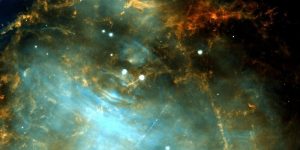In 2005, the Hubble Space Telescope snapped a picture of an asteroid streaking across the Crab Nebula—a celestial photobomb, if you will.
Melina Thévenot, a German amateur astronomer who works with the citizen science project Zooniverse to identify important objects in satellite imagery, recently spied the pale, white streak in a black and white image taken by Hubble, and processed the picture by combining the blue, green, and red filters to create a color image, according to a European Space Association press release.
The results are breathtaking.

Astronomers with the ground-based Lincoln Near-Earth Asteroid Research (LINEAR) survey first identified the asteroid, named 2001 SE101, in 2001, and have been monitoring it ever since.
It’s not entirely surprising that an asteroid would have photobombed this Crab Nebula image. The famous galaxy—also referred to as M1, or Messier 1—is located close to the orbital plane in which most of the Solar System’s asteroids can be found. In other words, it was only a matter of time before one appeared in a shot of the Crab Nebula.
Critically, these images allow scientists to map the trajectories of asteroids plodding along through space. By capturing the exact date, time, and position of the asteroid, researchers can plot whether the rock may be on a collision course with Earth.
Source: yahoo
Ask me anything
Explore related questions





